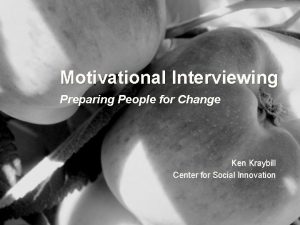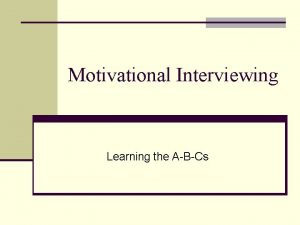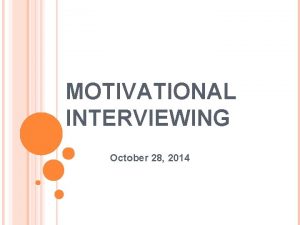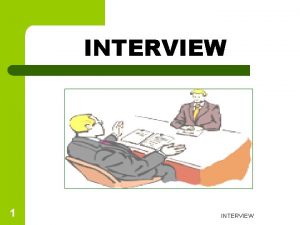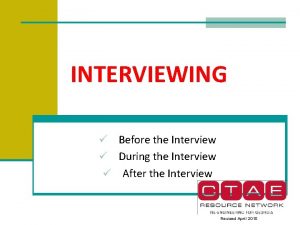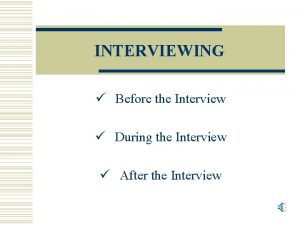An Introduction to Motivational Interviewing Using Motivational Interview

















- Slides: 17

An Introduction to Motivational Interviewing Using Motivational Interview Techniques as a Tool for Establishing Current Condition 1

Usually when we want our child or our employee to do something, we often just tell them to, “Go do X. ” But have you ever asked your: • child to do their homework… • staff to change a procedure… …and then they didn’t do it? And even repeatedly asking them to do it, getting angry, or arguing didn’t help? 2

• Everyone wants to do well. • Sometimes we need help processing why we are not doing what we need to do. • If someone is not meeting expectations, they may feel defensive. Motivational Interviewing is asking the right question, in a non-judgmental way, to help uncover what is going on. 3

What is Motivational Interviewing? • Traditionally, motivational interviewing is used as a psychotherapy technique to help clients who aren’t yet fully committed to making a change. • Motivational interviewing doesn’t have to be reserved for therapeutic relationships. • It’s a respectful way to help other people weigh the pros and cons of change, while also addressing their concerns. 4

Four Principles of Motivational Interviewing The “OARS” Open Ended Questions Affirmations Reflective Listening Summary Statements 5

Principles of Motivational Interviewing Open Ended Questions An open-ended question, cannot be answered with a limited response, (i. e. “yes”, “no”, “maybe”, “seven”, “next week”, etc. ). They help individuals investigate and explore their own thinking and desire for change (or not). 6

Open Ended Questions Ask the open ended questions and then be quiet and really listen. For example: • “What do you need? ” • “What do you think could be helpful? ” • “What might improve things? ” 7

Principles of Motivational Interviewing Affirmations Affirming statements allow for both recognition of difficulties and support of strengths, letting people know their concerns and issues are valid. 8

Affirmations Show acceptance and acknowledge the difficulties the other person is experiencing. For example: • “I see what you mean. That makes sense to me. ” • “I see how much you care about your work. This is a real challenge for all of us. ” • “I understand. I would feel frustrated too. ” 9

Principles of Motivational Interviewing Reflective Listening Paraphrase (mirror) the individuals’ comments by repeating back what they said. This lets them know you heard what they said and it makes sure you heard what you think you heard. 10

Reflective Listening For example: • “So, it sounds like there a lot of interruptions that can’t be avoided and that’s part of the problem? ” • “It sounds like you really like your new position, but it feels like the transition is moving too quickly? ” • “So, what you’re saying is, everyone has been helpful, but you feel like you’re not being heard? ” 11

Principles of Motivational Interviewing Summary Statement Summary statements pull together everything stated. 12

Summary Statement • “Let me see if I understand this so far…. ” • “Here is what I’ve heard…” • “So, this week, you need to talk with your supervisor about training at a slower pace for a little while. . . ” Followed with: “So, does that seem accurate to you? ” “Did I miss anything? ” “Is there something more. ” 13

Motivational Interviewing as a Tool to Establish Current Condition • The Current Condition is how things actually work 80% of the time, it is not how things should work. • It takes courage, on all parts, to accurately pursue this information. • Honesty is crucial in establishing the Current Condition, so you need make it comfortable for staff to tell you what the Current Condition really is. • Staff may have an easier time being completely candid if they are not interviewed by their supervisor. 14

Motivational Interviewing as a Tool to Establish Current Condition Lead in by showing empathy and respect for the staff by creating a supportive and safe environment: • “We know where we want to be, but in order to move in that direction, we need to understand the situation as it is. So, I’m gathering some information to help establish our ‘Current Condition’. I just want to ask a few questions about what happens most of the time, 80% or more of the time. ” 15

Motivational Interviewing as a Tool to Establish Current Condition • Staff may feel, overwhelmed, over-worked, frustrated, and/or defensive. The interviewer should remain calm and empathetic – regardless of how disappointing/shocking/aggravating the truth might be. • Ask open ended questions and keep the conversation focused on the facts. • Take detailed notes. • Using an “anonymous” form can be helpful. • Stay focused. Don’t go off into the weeds. -Write those other items down to be addressed later. • Don’t allow the conversation to dissolve into complaining or gossip. 16

Motivational Interviewing as a Tool to Establish Current Condition The data collected through research and interviews are compiled to determine your Current Condition. 17
 Rolling with resistance motivational interviewing examples
Rolling with resistance motivational interviewing examples Motivational interviewing
Motivational interviewing Dears motivational interviewing
Dears motivational interviewing Motivational interviewing schizophrenia
Motivational interviewing schizophrenia Cris cannon
Cris cannon Dears motivational interviewing
Dears motivational interviewing Desire ability reason need
Desire ability reason need Motivational interviewing stages of change
Motivational interviewing stages of change German motivational speech
German motivational speech Motivational interviewing
Motivational interviewing Decisional balance
Decisional balance Amplified reflection example
Amplified reflection example Mi readiness ruler
Mi readiness ruler Motivational interviewing
Motivational interviewing Darn cat change talk
Darn cat change talk Dares motivational interviewing
Dares motivational interviewing Stages of change social work
Stages of change social work Darn cat motivational interviewing
Darn cat motivational interviewing










